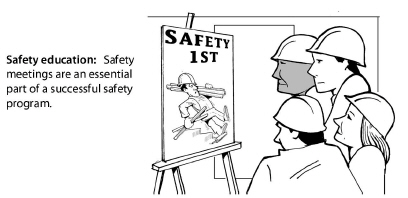
|
SWS Detail: 2.0100.1 Global Worker Safety, 2.0106.1 Ventilation Worker Safety |
The personal health and safety of each employee is vitally important to every weatherization agency. Injuries are the fourth leading cause of death in the United States, while long-term exposure to toxic materials contributes to sickness, absenteeism, and death of workers. Both injury hazards and toxic substances are present during weatherization work.
The Occupational Safety and Health Administration (OSHA) establishes workplace safety standards. Weatherization staff and contractors must attend training on OSHA standards and observe these standards on the job. Safety always has priority over other factors affecting weatherization operations.
Some hazards deserve attention because of their statistical danger. Become aware of these most common workplace hazards.
ü Vehicle accidents
ü Falls
ü Back injuries
ü Exposure to hazardous materials
ü Electrical hazards
ü Repetitive stress injuries
Workers may not remember safe work practices unless safety is periodically reinforced.

ü Arrange regular health and safety training.
ü Conduct monthly safety meetings at headquarters and weekly safety meetings on the current jobsite.
ü Provide well-equipped first-aid kits in the work vehicles and in the warehouse.
ü Provide or require personal protective equipment for workers appropriate for their job duties.
ü Provide a fire exchanger in the warehouse and each work vehicle.
ü Keep equipment in good condition.
ü Observe all state and federal standards relating to worker health and safety.
ü Keep lists of emergency-contact phone numbers for both employees and emergency services in the warehouse and in the work vehicles.
ü Keep Material Safety Data Sheets (MSDSs) in the warehouse and in the work vehicles.
Safety requires communication and action. To protect yourself from injury and illness, learn to recognize hazards, communicate with co-workers and supervisors, and take action to reduce or eliminate hazards.
New employees are several times more likely to injure themselves on the job compared to experienced workers. Before their first day on the job, new employees should learn about safety basics such as proper lifting, safe ladder usage, and safe operation of the power tools they will use on the job.
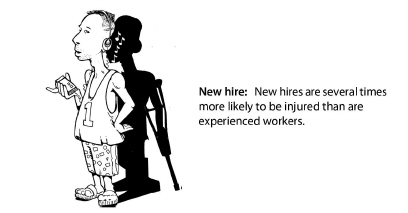
Be sure to inform new employees about hazardous materials they may encounter on the job. Show new hires the Material Safety Data Sheets (MSDS) required by OSHA for each material.
New employees should be required to use this common safety equipment.
ü Proper clothing.
ü Leather gloves with cuffs.
ü Safety glasses.
ü Hearing protectors.
Ban alcohol and drugs from agency headquarters and the job. Staff members should be encouraged to refrain from smoking and to stay physically fit.
According to the Bureau of Labor Statistics, one-third of all occupational fatalities in the United States occur in motor-vehicle accidents. Staff members should organize their errands and commuting to the job site so as to minimize vehicle travel.
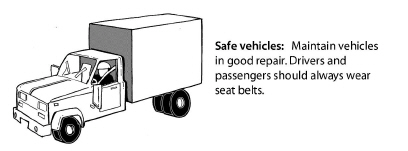
Vehicles should be regularly inspected and repaired if necessary. Verify that these safety features are present and functioning.
ü Brake system
ü Steering system
ü Horn
ü Headlights
ü Rear-view and side-view mirrors
ü Directional signals
ü Backup lights
ü A fire extinguisher
Always wear seat belts. Before traveling to the job, secure tools and materials in the vehicle’s cargo area to prevent shifting.
1.8.4 Lifting and Back Injuries
Back injuries account for one out of every five workplace injuries. Most of these injuries are to the lower back and result from improper lifting, crawling in tight spaces, and using heavy tools.
Workers often injure their backs by lifting heavy or awkward loads improperly or without help. Use proper lifting techniques such as lifting with the legs and keeping a straight back whenever possible. To avoid back injury, get help before trying to lift heavy or awkward loads, stay in good physical condition, and control your weight through diet and exercise.
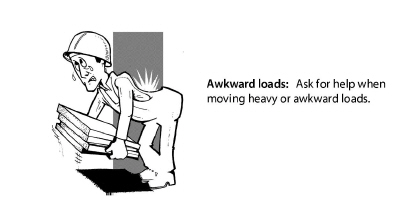
Workers with limited lifting abilities because of weakness or prior injury should avoid heavy lifting.
These policies help prevent jobsite injuries.
ü Redesign work activities: adapt equipment to minimize awkward movements on the job site.
ü Perform strength-testing of workers, set lifting limits, and provide training for all workers on the causes and prevention of back injuries.
ü Encourage breaks to prevent workers from being in straining positions for long time periods.
ü Share the most difficult work among all capable crew members.
|
SWS Detail: 2.0100.1 Global Worker Safety, 4.9901.1 General Information on Spray Polyurethane Foam (SPF), 2.0106.1 Ventilation Worker Safety |
Wear your respirator when working in a polluted environment. Common construction dust can contain toxins including lead, asbestos, and chemicals released by drilling, cutting, scraping. Liquid foam, caulking, and solvents release toxic organic vapors that require either organic vapor cartridges or a fresh-air supply.
Test your respirators to be sure they have a good fit.
ü Check the straps and face piece to be sure they are soft and free of cracks.
ü Strap on the respirator and adjust the straps to be snug but comfortable.
ü Close the exhalation valve with a hand.
ü Exhale gently and check for leaks around the edges.
ü If there are leaks, adjust or repair the respirator.
When applying low pressure 2-component spray polyurethane foam, wear an air purifying mask with an organic vapor cartridge and a P-100 particulate filter.
Workers with beards, facial scars, and thick temple bars on eyeglasses must use full-face respirators to achieve a good seal. OSHA requires a completed form documenting employees’ fit tests each year.
When spraying low-pressure polyurethane foam, use a respirator cartridge designed to filter organic vapors, and ventilate the area where you’re spraying the foam. When spraying high-pressure polyurethane foam, use a supplied-air, positive-pressure respirator, and ventilate the area.
Learn how to recognize asbestos insulation that may be installed around older furnaces and boilers.
Control dust in your client’s homes by erecting temporary barriers when you are doing work that may release dust. Wear coveralls when entering attics or crawl spaces. Coveralls should be disposable or laundered professionally.
|
SWS Detail: 2.0110.1 Material Selection, Labeling, and Material Safety Data Sheets (MSDSs), 2.0100.1 Global Worker Safety |
Your health and safety can be threatened by hazardous materials used on the job. Workers often fail to protect themselves from hazardous materials because they don’t recognize the hazards. Breathing hazardous materials, absorbing them through the skin, and coming into eye contact with hazardous materials are common ways workers are injured by chemicals.
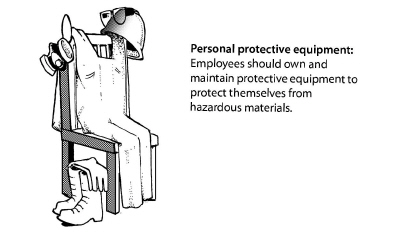
OSHA regulations require employers to notify and train employees about hazardous materials used on the job. A Material Safety Data Sheet (MSDS) for every workplace hazardous material should be readily available to employees. Obtain copies of MSDSs from manufacturers or their distributors. OSHA requires that the MSDSs be available at headquarters and at the jobsite for worker reference.
Learn how to handle hazardous materials used on the job. Use the personal protective equipment (PPE) that is recommended by the MSDS.
1.8.7 Equipment for Personal and Crew Safety
Worker should have their own personal protective equipment.
• Respirators with dust and organic-vapor cannisters
• Clean cloth coveralls or disposable coveralls
• Gloves
• Safety glasses
• Hearing protection
• Hard hat for head-injury hazards
Crews should equip themselves with the safety equipment listed here.
• Ladder levelers and stabilizers
• Portable lights for work in dark areas
• A water jug
• Insect spray
• Safe, heavy electrical cords with GFCI receptacles
Falls off ladders and stairs cause 13% of workplace injuries according to the National Safety Council. Falls from the same elevation such as slips and trips account for approximately 7% of workplace injuries.
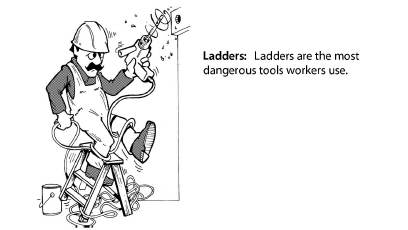
Broken ladders and unstable ladders are both major causes of on-the-job falls. Step ladders, for instance, are often used for work that is too far off the ground, forcing workers to stand on the top step or to reach too far.
OSHA regulations include these important guidelines for ladder use.
ü Maintain all ladders in good repair, and replace ladders if they have missing or damaged steps, cracked side-rails, or damaged feet.
ü Extend extension ladders at least three feet above the area they access.
ü Ladders shouldn’t have a pitch steeper than four feet of rise for each foot that the ladder’s feet are away from the building.
ü Block or tie ladders firmly in place at the top and bottom if you install the ladder at a steeper angle than suggested above or on windy days.
ü Don’t use metal ladders where they may accidentally touch electrical conductors.
ü Maintain ladders free of oil, grease, and other slipping hazards. Inspect your shoes for slipping hazard before climbing a ladder.
ü Don’t over-reach: instead move the ladder.
ü Avoid carrying heavy loads up ladders and operating power tools from ladders.
Build scaffolding when working above-ground for sustained time periods. Each scaffold leg should be stabilized so that it supports an equal weight as other legs. Secure planks to the structure and provide handrails on the sides and ends of the walkway.
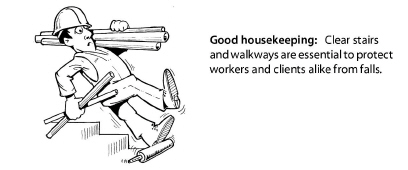
Workers should inspect their workplaces regularly to notice and remove slipping and tripping hazards. Workers carrying loads should create and maintain debris-free walkways.
The tools used in construction work are dangerous if used improperly. About 90,000 people hurt themselves with hand tools each year. The crew chief should conduct tool safety training as frequently as necessary to insure safe tool use.
These basic safety rules can reduce the hazards of using hand and power tools.
ü Use the right tool for the job.
ü Keep all tools in good condition with regular maintenance.
ü Inspect tools for damage before using them.
ü Operate tools according to the manufacturer’s instructions.
ü Use appropriate personal protective equipment.
ü Use double insulated power tools of ground-fault-circuit-interrupter (GFCI) outlets or extension cords to prevent electric shock.
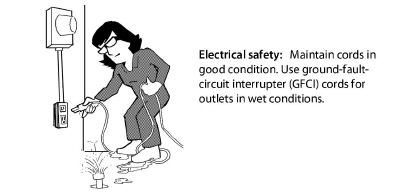
ü Use generators for electrical service on the jobsite and ground them.
ü Verify that generator exhaust is directed away from the home, the vehicle, and the crew.
1.8.10 Repetitive Stress Injuries
Repetitive stress injuries are caused by over-working certain parts of your body. Poor body posture, such as reaching above your head when operating a power drill, can encourage these injuries. Good work habits prevent this type of injury.
ü Use a comfortable arm and hand posture when operating tools for a long period of time.
ü Change the angle and location of your work surface frequently.
ü Mix your difficult tasks with easier ones.
ü Carry smaller loads.
ü Take short rest breaks periodically, and stretch any tight muscles during this time.
When you purchase hand and power tools, look for models with ergonomic designs that place less stress on your body.
1.8.11 Safety for Crawl Spaces and Other Confined Areas
|
SWS Detail: 2.0701.1 Crawl Spaces—Providing Access, 2.0701.2 Crawl Space Information Sign |
The Occupational Safety and Health Administration (OSHA) defines a confined space as a space that contains a hazard like confinement, limited access, or restricted airflow because of its small size.
Access to Confined Spaces
Employers must be aware of the hazards of confined spaces and have policies for protecting workers. Consider these requirements when appropriate.
ü The crawl space must have an access hatch or door that is 24 inches by 18 inches.
ü Workers should identify access and egress points before entering a confined space.
ü If a heating and cooling system is located in the crawl space, the crawl space must have an access hatch or door measuring 22 inches by 30 inches or big enough to remove the heating and cooling system, whichever is greater.
Chemicals in Confined Space
Observe these requirements when using chemicals in confined spaces.
ü At minimum, workers using any type of chemical in a confined space must employ continuous powered ventilation using adequately sized openings to facilitate airflow into and out of the confined space.
ü If workers use chemicals in significant quantities, such as spraying of two-part polyurethane foam, the workers should wear respirators that supply fresh air.
ü If a confined space contains a hazard like chemical vapors or the potential to collapse or trap a worker, the space is called a permit-required confined space (PRCS). A worker must have a permit to enter the space and workers without permits must not enter. The permitted workers must have special training and equipment to enter the confined space.
1.8.12 Safety for Extreme Weather
Extreme weather is a common cause of job-related sickness and injury. You can avoid sickness and injury by awareness and preventive measures.
Hot Weather Safety
Know the signs of heat ailments and take action if you or a co-worker experiences the beginning of symptoms. Observe these hot-weather suggestions for staying cool and preventing heat ailments.
ü Drink plenty of water and take salt tablets.
ü Ventilate attics with fans.
ü Rotate workers in attics to prevent heat exhaustion.
ü Use water or ice to cool your skin.
ü Rest when you feel fatigued.
Cold Weather Safety
Workers and supervisors should know the temperature, wind speed, and precipitation forecast. Dress for extreme cold and plan work around storms and other extreme weather events.
ü Dress in layers for comfort and changing temperatures.
ü Wear insulated boots or heavy socks.
ü Wear insulated gloves.
ü Seek warm shelter if you experience numbness or uncomfortable chilling.
Windy Weather Safety
Be aware of forecast for windy weather and take precautions before beginning work or before the wind blows.
ü Tie ladders off high and anchor them low.
ü Avoid carrying sheet goods that could act as a sail allowing the wind to blow you over.
ü Store materials and tools where the wind can’t move them.